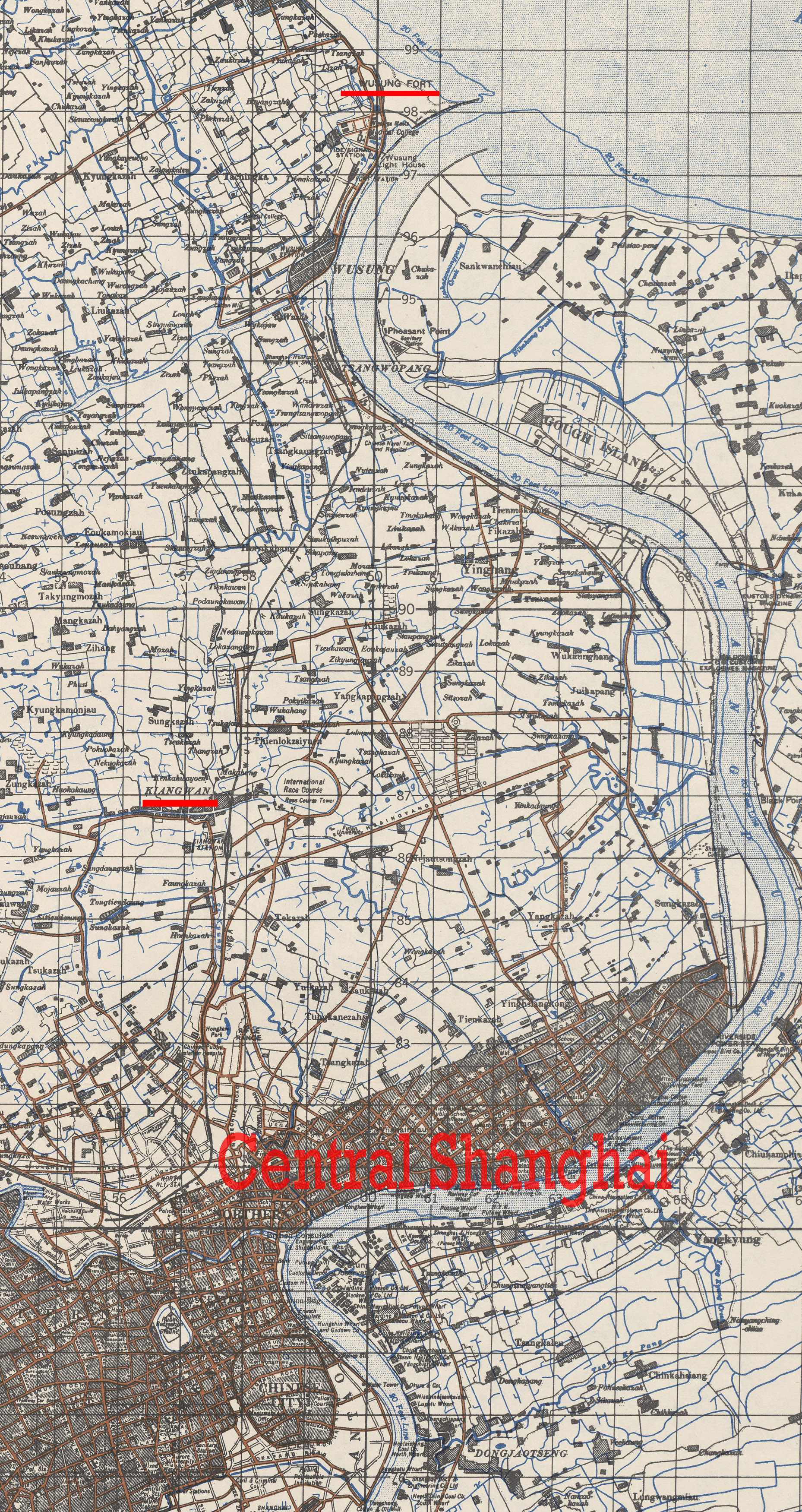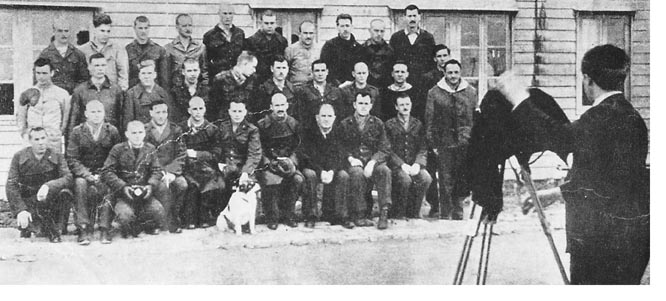![]()
WARD ROAD JAIL-SHANGHAI Report
SENDAI # 7 held Eugene Litz, James Somers, Frank Stockton, and Walter Freiberger at the end of the war. They were transferred there from the Tsumori and Kawasaki camps.
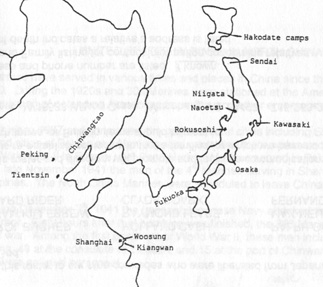

|
|||||||||
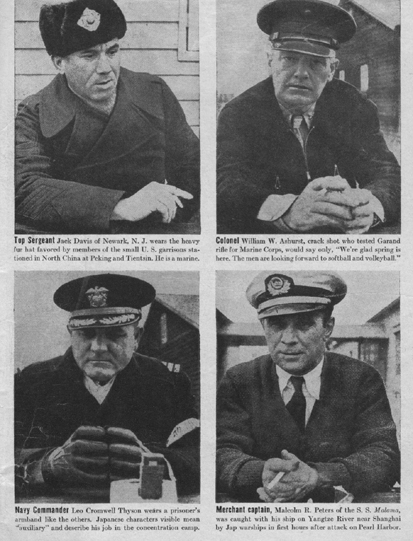
|
|||||||||
Top row: Bernard F. Kelly, William H. Boyden, Francis L. Plog, Robert L. Armstrong (?), Norman R. Estep, John D. Pitner, Steve A. Salay or James Wilson, Harold I. Retzke, Frank J. Novak, Raymond E. Smith.Middle: Jimmie L. Stewart, Edgar A. Croteau, Harold (Doc) Hoffman, Charles W. Parr (?), Norman Berg or Martin Gatewood, Kenneth W. Davis, Fernando C. Rodriquez or Antonio Leon, Gerald A. Newhouse, Michael J. Schick, Edward (Moose) Kirkpatrick.Front: Jack Davis, ______, John H. Ellison, Herman Davis, Walter E. Freiberger, Danny Walmer, Morris F. Haugo, Frank (Dutch) Miller, John (Tex) Castleton, Roy A. Dobson, Herman Wolf. Dog is Ergo.The Fall of Shanghai by Noel Barber describes Woosung as such: "In winter sleet and snow whistled round every corner, and then fogs, drifting in from the sea, chilled you to the bone ... Yet if the winter was long and cruel, the summer was even worse; for then came the heat..."Wake Island civilian John O. YOung said about Woosung "Not enough food, sickness, beatings were all part of prison life. If one would see a cute puppy or kitten we would not think of how cute they were, but could we catch them to eat."
Official Woosung report follows the description below
(note the details in this first hand description not mentioned in the official report)
WOOSUNG. Page 1 of 2
PRISONER OF WAR CAMPS IN AREAS OTHER THAN THE FOUR PRINCIPAL ISLANDS OF JAPAN LIAISON &
RESEARCH BRANCH AMERICAN PRISONER OF WAR INFORMATION BUREAU
By Capt. James I- Norwood and Capt. Emily L. Shek 31 July 1946
WOOSUNG CHINA
1. LOCATION: Woosung Camp is located 15 miles North of Shanghai and 5 miles Northeast of Woosung Forts. It is next to a radio station and was formerly used as a Japanese army barracks.
2. PRISONER PERSONNEL: The first group of prisoners to arrive in Woosung were the survivors of the USS Wake"
and the HMS "Petrel", plus the personnel captured on Wake Island. They arrived on 24 Jan. 1942, Up to the time of their arrival they were under the custody of the navy and at Woosung they were turned over to the army. On 1 Feb. 1942. the prisoners from Tientsin and Peking arrived making a total of 1500 prisoners: 700 were civilians. 700 army. navy and marine corps, and the rest made up of other nationalities. Col. Ashurst was the ranking officer and his assistant was Maj. Luther Brown. [Red Cross report of Sep 1942 gives number of prisoners as 47 British, 1500 Americans (military and civilian) 1 Japanese medical doctor, 4 POW medical doctors, 24 sick prisoners and 5 deceased POWs: 10 Sep 1945 report lists deaths as 17 Feb 42 civilian Mark Staten malnutrition, 18 Jun 42 civilian Lonnie B Riddle shot by guard-accidental, 15 Aug 42 S2c Ray K Hodgkins accidental electrocution on perimeter fence, 20 Aug 42 PFC Joseph F Commers tuberculosis, 28 Aug 42 Cpl Carroll W Bucher accidental electrocution on perimeter fence, 5 Oct 42 civilian Edward A Nelson ulcerated colitis, 31 Oct 42 civilian Lewis Carr brain tumor, 13 Nov 42 civilian Charles O Nelander ulcerated colitis. Same report lists Yuan Chin, civilian mess attendant from WSS Wake, died spring 42, cause unknown. Pan American employee J Camacho died 11 Aug 42 from cancer of the tongue. Both listed as being reported by Japanese as occurring in Shanghai. Deaths listed above are also listed in Colonel Otera's report submitted in August 1945. ]
3. GUARD PERSONNEL: The first Japanese commanding officer was 1st Lt. Takamato- He was replaced about a week later by Col- Yuse and upon his death in Sept, 1942, Col, Otera became the commanding officer of all Shanghai camps.
The immediate camp was under Capt. Endo who was formerly the executive officer of Col. Yuse. Lt. Akiyama was in charge of the guards. Lt. Suzuki, quartermaster, Lt. Shindo (now Capt.) medical officer and chief interpreter Mr. Ishihara. [The Beast of the East - see photos and sketches below]
4. GENERAL CONDITIONS: Conditions here were poor; health and sanitary facilities were inadequate, and from the first day written protests were filed by senior officers.
(a) Housing Facilities: The camp was made up of 7 old wooden barracks, one of the seven being a small barrack, the rest of them being approximately 210 feet long and 50 feet wide. These barracks were divided into sections holding about 36 men to a section. The men slept on raised platforms on bare boards. All the floors were of wood. The roofs were constructed of a metal covering camouflaged with paint. The windows were glass, and broken panes were never replaced. The officers were separated from the enlisted men at one end of the barracks. They had separate rooms with two to four in a room, depending on their rank- Each barracks housed about 230 men. The entire camp was surrounded by two electrically charged fences. [The March 1943 Red Cross report on a visit to the camp states Col Ashurts again requested screening for the barracks so as to prevent the malaria problems of the summer of 1942. The Red Cross promised to study the problem.]
(b) Latrines: The latrines were located behind the barracks about ten feet away. They were the usual type of Japanese latrines. The excreta was removed by coolies.
(c) Bathing: There were two bathrooms, one for officers and one for enlisted men. In each of these there was a large tub which contained hot water. The tub was approximately 5' high, 7' long and 4' wide. However, the prisoners were not allowed to get into the tubs. They were required to dip the water out of the tub and bathe from a bucket or other small container.
(d) Mess_Hall: A separate building housed the mess hall where the food was prepared by the prisoners. Cooking arrangements consisted of a number of large cauldrons set in brickwork. It had a concrete floor and was relatively clean. Section leaders detailed men to draw food from the mess hall and it was taken to the barracks where the food was served.
(e) Food: Rations for the first two months were very meager. A small bowl of rice, a bowl of stew, and tea composed the diet. In April 1942 the rations were increased to about 650 grams of rice per man per day. plus a quarter pound of meat per man per day. Later the issue of meat was discontinued. Fish (squid) was given to the prisoners on a few occasions. [Red Cross reports make reference to 600 pounds of bacon or ham delivered fortnightly. Major Brown is quoted in a report as saying when the meat is delivered it was all cooked and served at that time so as to give the men one decent meal rather than try to make the meat last over a period of time. The 600 pounds would equate to 4 tenths of a pound per man for one meal. Those Red Cross reports state deliveries of that meat and fruits would not be available in any quantities after April 1942.]
In Aug. 1942 the prisoners of war gardens began to produce, but the Japanese took most of the vegetables. The only potable liquid was tea served in cups five times a day. No arrangements were made for drinking water. The whole supply of water came from a surface well about 30 feet deep. All prisoners were warned not to drink the water. [Red Cross reports say suggestions as to how to solve the water problem were not acted on.]
(0 Medical Facilities: Both medicine and accommodations were insufficient and inadequate. The administering of the sick was left to the three American doctors and the corps men. Capt. Thyson was the senior American doctor. He brought with him a supply of drugs and they lasted until July 1942.
(g) Supplies: In the beginning the Red Cross was not allowed to visit or send supplies, but when Col. Otera took over, clothing, medical and food supplies were delivered by the Red Cross- The American Association, through donations was able to equip the camp with a laboratory, x-ray room, infirmary and a dental room. The Japanese issued a few pairs of shoes, also some clothing to the men from Wake Island. Each man received four cotton blankets which was insufficient for the cold winter. The men from Tientsin managed to bring their blankets and clothing with them while the Wake Island
prisoners only had tropical clothing At first no soap was issued but later a bar of soap was issued every three months. [Red Cross reports say that although medical equipment was available by March 1942 it had not been installed or it was broken.]
(h) Mail: Letters were allowed to be written but had to follow a Japanese outlined form. The first mail to arrive in camp was Sept. 1942. Up to this time they had been receiving only local mail. [Examples of these letters can be seen on the page POW Letters and Documents.]
WOOSUNG,Page2of2
(i) Work: In the early part of April the enlisted men, and civilians, worked at leveling a field, which was to be used as a Japanese parade ground. The men also did farm work and repairing the roads. Later the enlisted men were ordered to polish empty shell cases. Col. Ashurst protested to the Japanese authorities and after much haranguing this was stopped.
The officers were never forced to do manual labor, but in some cases they were made to supervise the enlisted men.
(j) Treatment: The guards did not treat the men too well. Face slapping was a common occurrence- Mass punishment occurred on several occasions. The offenses of a few prisoners, as an object lesson to all. brought such infliction as standing in the rain for many hours, the slopping of food for days, or close confinement. These punishments were inflicted upon groups of men regardless of whether or not they had anything to do with the particular breach of rule. All prisoners
were ordered and forced to sign a pledge that they would not escape, [deprivation of food and close confinement were threatened and carried out to some point to force POWs to sign this pledge]
(k) Pay: The officers received pay in accordance to the amount paid the Japanese officers of the same rank:
2"" Lt....................... 70,83 yen 1st Lt.................. 85.00 yen Capt................... 122,50 yen
Major ...................... 170,00 yen Lt. Col. .............. 230-00 yen Col................... '312.50 yen
Sixty yen was deducted for room and board:
Food .................................4200 yen
Clothing ............................... 1500
Furniture and Electricity........ 3,00
......,-..--,.........,..,..60,00
The enlisted men were divided into two classes, namely, a specialist and an ordinary class. The specialist received 15 sen a day, and an ordinary worker received 5 sen a day.[These payments were meaningless. In many cases the POWs never received them. In most cases the amounts were entered into record books and then subtracted for food or clothing supplied by the Japanese.]
(I) Recreation: The recreation facilities, as a whole, were considered satisfactory. The prisoners had soft ball teams and there was a soft ball diamond. They also had a small orchestra and a glee club. and frequently put on entertainingshows. After working hours they were allowed to play cards.
(m) Religious Activities: Once a month a Japanese minister came into camp to perform services.
(n) Morale: At this time most of the prisoners were optimistic and thought they soon would be exchanged.
5. MOVEMENT: On 18 Sept. 1942, a group of men, about 70. consisting of laborers, technicians, specialists, etc . were
transferred to Japan. First days of Nov 42 another group of military and civilian POWs were transferred to Japan. Believed all POWs from Sep and Nov shipment sent to Fukuoka 3-B on Kyushu. On 6 Dec. 1942, the entire camp was moved to Kiangwan. All Japanese officers and guards moved with them. End Report
Colonel Otera's report in August 1945 lists the following transfers from Woosung:
13 Sep 1942 - Sir Mark Young and 1 British (to Taiwan)
18 Sep 1942 - 69 US civilians and 1 US Marine (to Fukuoka 3-B)
3 Nov 1942 - 12 civilians and 58 US Marines (to Fukuoka 3-B)
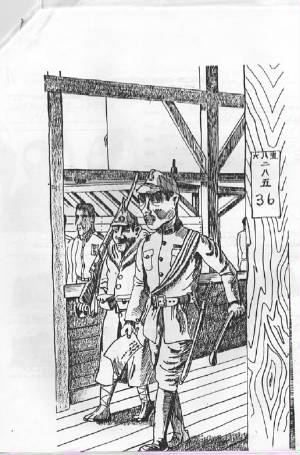
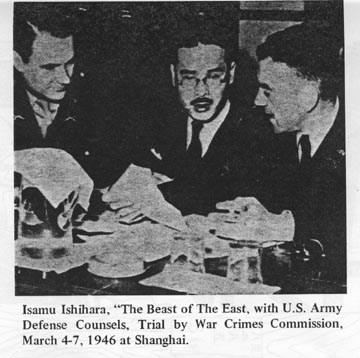
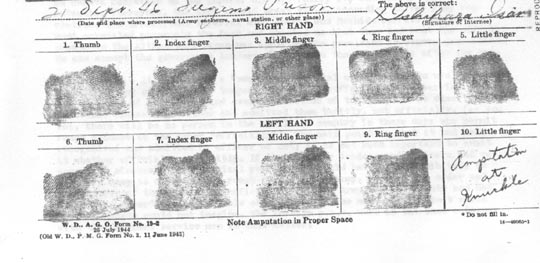
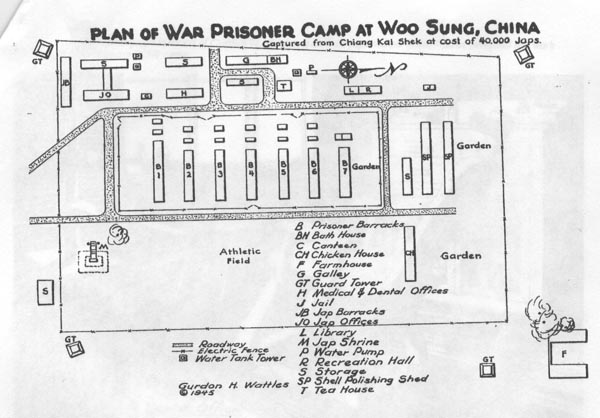
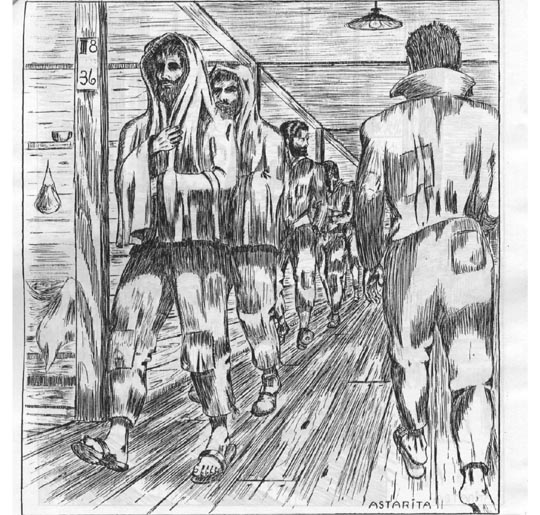
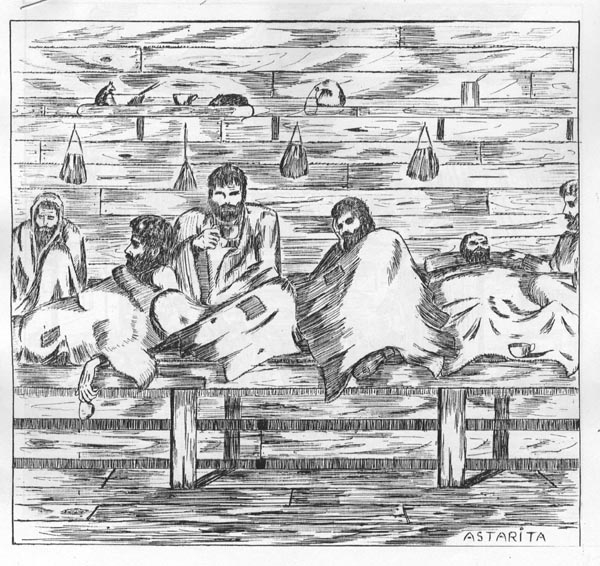
Click here for Wake Island Marine narratives on Woosung and Naoetsu.
Colonel Otera's papers list the following as being repatriated from Woosung:
29 May 1942 - Aaron Billingsley, Thomas Marshall, Albert Morgan, George Welchman, Walter Melly, Graham Summers, and Edward Godwin of the British Embassy in Peking
9 June 1942 - Laurence Hall (Radioman USN), Paul Chandler, Henry Kijak, Loren Schneider, Nathan Smith (all USMC from the 4th Marines)
7 August 1942 - Charles Sheppard (British Embassy Shanghai), John Kennedy, David Kermode, Norman Hart-Baker, Rodney Horne, Ralph Keen (all Royal Navy), British Marines Edwin Sansom, William Burfield, RASC Cedric Fox, William Peckam, Navy writer Victor W. ??, and another illegible name on the British list
28 April 1944 from Kiangwan Estonian Ferdinand Reinthall, wireless officer of the SS Mary Woller was repatriated
Woosung and Kiangwan are each approximately located on the map below. Ward Road Jail is at the foot of the letter "n" in Central.
